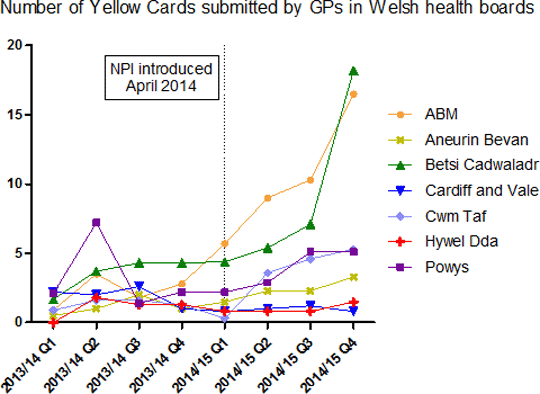Print version
Search Pub Med
Changes In Yellow Card Reporting In Wales Following The Introduction Of A National Prescribing Indicator
Introduction: The Yellow Card Scheme is the spontaneoussuspected adverse drug reaction (ADR) reporting scheme in the UK. It represents an important post-marketing mechanism for reporting possible ADRs which may only be identified when a medicine is used by a large number of patients in day to day clinical practice. The MHRA uses the data to update the information provided on medicines, to minimise risk and maximise benefit for patients. The All Wales Medicines Strategy Group (AWMSG) endorses National Prescribing Indicators (NPIs) as a means of promoting safe and cost-effective prescribing. NPIs encourage health boards to focus educational interventions on strategic areas of prescribing and (in this case) reporting. Yellow Card submissions were included as an NPI in Wales for the financial year 2014–2015. The aim of this quasi-experimental study was to assess whether the number of yellow cards submitted in Wales changed in association withthe introduction of the NPI in April 2014. Method: The number of yellow cards submitted by GPs in Wales perfinancial quarter in the 12 months prior to (April 2013 to March 2014) and 12 months following (April 2014 to March 2015) the introduction of the NPI was obtained from the Yellow Card Centre (YCC Wales). The number of reports pre- and post- intervention submitted by GPs in Wales, as well as those submitted by GPs in each of the seven health boards was compared using Mann Whitney U test. The number of Yellow Cards submitted by GPs in England in 2013-2014 and 2014-2015 (pre- and post- introduction of the NPI in Wales) was also compared to the number submitted by GPsin Wales over the same period using Chi Square analysis. Results: The number of Yellow cards submitted by GPs across the health boards in Wales per financial quarter is shown in the figure below. The number of Yellow Cards submitted in England in 2013–2014 and 2014–2015 was 3,629 and 4,232 respectively, and the number submitted in Wales over the same period was 271 and 662 respectively (p<0.001, Chi Square analysis). Discussion: The median number of Yellow Cards submitted by GPs in Wales per financial quarterwas significantly greater in 2014–2015 compared to the previous year. Whilst the timing of the increase in reporting coincided with the introduction of the NPI, the quasi-experimental design of this study did not allow a direct association with the NPI to be made. There was considerable variation in themagnitude of change in reporting by GPs across the different health boards in Wales. Yellow Card reporting was one of 14 NPIs across eight areas of practice in 2014–2015; therefore it is likely that each health board had different priority areasfor practices to review. Some educational initiatives were introduced and at least one health board introduced a local incentive scheme to reward reporting. These differences may have beenassociated with the variation in response across the country as a whole. Yellow Card reporting remains an NPI for the financial year 2015–2016.
Conclusion: There was a significant (144%) increase in the rates of yellow card reporting in the health boards in Wales in 2014-15 compared with the previous financial year. This increase was associated in time with the introduction of a national prescribing indicator (NPI) highlighting reporting as a quality indicator in primary care. In England, where an NPI was not introduced, there was only a 17% increase in 2014-15 compared with the previous financial year.
|


